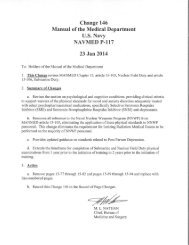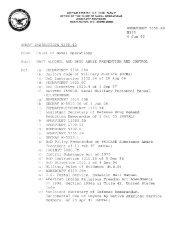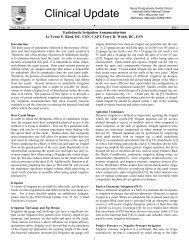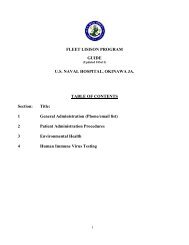Palliative Care - Navy Medicine
Palliative Care - Navy Medicine
Palliative Care - Navy Medicine
You also want an ePaper? Increase the reach of your titles
YUMPU automatically turns print PDFs into web optimized ePapers that Google loves.
End of Life <strong>Care</strong> in the ICU<br />
C.M. Stafford, MD, FCCP<br />
Medical Director, Intensive <strong>Care</strong> Unit<br />
Chairman, Healthcare Ethics Committee<br />
Naval Medical Center San Diego<br />
The views expressed in this presentation are those of the author and do not<br />
necessarily reflect the official policy or position of the Department of the<br />
<strong>Navy</strong>, Department of Defense, or the United States Government.
Disclosures<br />
The speaker has nothing to disclose.<br />
Exhibits coordinated through the Henry<br />
Jackson Foundation.<br />
Refreshments provided through the Henry<br />
Jackson Foundation.
Outline<br />
(Sobering) epidemiology<br />
Definitions / Problem<br />
Common ICU Cases<br />
Protocols?
Statistics<br />
50% of patients with chronic illness who<br />
die in a hospital are admitted to ICU within<br />
last 3 days of their life<br />
15% of patients admitted to ICU (500,000)<br />
per year experience death<br />
22% of all deaths occur in ICU<br />
Angus, Critical <strong>Care</strong> Med, 2004.<br />
Luce, Oxford Press, 2001.
Comfort care:<br />
Definition<br />
– <strong>Care</strong> with the primary goal of promotion of comfort,<br />
not to cure or prolong life<br />
– Aimed at improving quality of life and should address<br />
psychological, social, and spiritual needs<br />
– May involve withholding or withdrawal of treatments<br />
intended to extend life
Problem<br />
Medical education dedicated to saving life<br />
yet little attention directed at end of life<br />
Is comfort care in the ICU a ‘procedure?’
Case 1<br />
89 M with ESRD, respiratory failure, &<br />
sepsis.<br />
Wife selects comfort care.<br />
Fluids, labs, rads, and feeds are stopped.<br />
Daughter arrives from NY. Very angry<br />
about no feeding. “Starving him!<br />
Barbaric!”<br />
What do you tell her?
Case 1 Response<br />
Appetite / hunger are lost close to death<br />
Risk of increasing pulmonary secretions or<br />
causing pulmonary edema<br />
No compelling evidence that dehydration<br />
or forgoing nutrition in the dying patient<br />
leads to significant suffering<br />
Quill, JAMA, 1997.
Case 2<br />
89 M with ESRD, respiratory failure, &<br />
sepsis.<br />
Wife selects comfort care.<br />
Fluids, labs, rads, feeds are stopped.<br />
Nurse asks, “Is it is ok to turn off the<br />
monitors?”
Case 2 Response<br />
Monitoring does NOT provide any<br />
additional comfort to the patient<br />
Can assess distress using physical exam<br />
and observation<br />
Family members may focus on monitor<br />
instead of the patient
Case 3<br />
89 M with ESRD, respiratory failure, &<br />
sepsis.<br />
Wife selects comfort care and extubation.<br />
Nurse predicts that patient will have<br />
significant respiratory distress and<br />
suggests a dose of paralytic.<br />
What is your response?
Case 3 Response<br />
Giving paralytics to make a patient “look”<br />
comfortable is unacceptable<br />
These agents have no sedative or<br />
analgesic effects<br />
Paralytics makes it impossible to assess a<br />
patient’s level of comfort
Case 4<br />
89 M with ESRD, respiratory failure, and<br />
sepsis.<br />
Wife selects comfort care and desires<br />
extubation.<br />
Call Resp Therapy and prepare the team<br />
Nurse reminds you that patient is receiving<br />
continuous infusion of vecuronium<br />
What do you do?
Case 4 (Controversial) Response<br />
Allow paralytic medication to wear off<br />
Pharmacologically reverse the medication<br />
If restoring neurologic function would pose<br />
an unacceptable delay (high doses,<br />
liver/renal failure), withdrawal may<br />
proceed, with attention given to ensuring<br />
comfort of patient<br />
Truong, Crit <strong>Care</strong> Med, 2008.
Case 5<br />
89 M with ESRD, respiratory failure, and<br />
sepsis.<br />
Wife selects comfort care and desires<br />
extubation.<br />
You are nervous about pulling the tube.<br />
What are signs of respiratory distress?<br />
What medications may be helpful?<br />
What is an appropriate dose?
What are signs of resp distress?<br />
Respiratory distress:<br />
– Tachypnea<br />
– Tachycardia<br />
– Fearful facial expression<br />
– Accessory muscle use<br />
– Paradoxic breathing<br />
– Nasal flaring
What meds may be helpful?<br />
Narcotics reduce sensation of dyspnea<br />
Goal: alleviate, prevent pain and dyspnea<br />
Infusion is most common method<br />
Emergence of symptoms should prompt<br />
bolus and increase in rate to rapidly<br />
address issue
What meds may be helpful?<br />
Morphine preferred agent for pain/dyspnea<br />
Advantages:<br />
– Effective, low cost, euphoric properties,<br />
familiarity<br />
Disadvantages:<br />
– More histamine release
How much do I give?<br />
Retrospective review of 3 Canadian ICUs<br />
over 1 year period<br />
417 patients underwent withdrawal of care<br />
86% received some form of morphine<br />
Median dose at time of death: 14.4 mg/hr<br />
Range at time of death: 0.7 – 350 mg/hr<br />
Keenan, CCM, 1997.
Open ended orders?<br />
“Begin morphine at 1 mg/hr, then titrate to<br />
comfort”<br />
ICU nurses were asked to interpret clinical<br />
scenarios and the use of narcotics<br />
Significant variability in nursing<br />
interpretation of “open-ended” orders<br />
Problematic<br />
Hall, Can J Anesth, 2004.
Doctrine of Double Effect<br />
“It is widely recognized that the provision<br />
of pain medication is ethically and<br />
professionally acceptable even when the<br />
treatment may hasten the patient’s death if<br />
the medication is intended to alleviate pain<br />
and severe discomfort, not to cause<br />
death.”<br />
– US Supreme Court Chief Justice Rehnquist
Doctrine of Double Effect<br />
Intentions are critically important<br />
Verbal and written communication must<br />
express intention to relieve pain and<br />
suffering
Case 6<br />
89 M with ESRD, respiratory failure, and<br />
sepsis.<br />
Wife selects comfort care and desires<br />
extubation.<br />
Nurse wants to use O2 via NC<br />
Resp Therapy objects and starts argument<br />
Wife is distressed and asks you if O2 is a<br />
good idea?
Case 6 Response
Debatable<br />
Case 6 Response<br />
Probably has no physiologic benefit<br />
One more tube on their face<br />
Probably not harmful<br />
Driven by family / care giver expectations
Case 7<br />
89 M with ESRD, respiratory failure, and<br />
sepsis.<br />
Wife selects comfort care and desires<br />
extubation.<br />
His breathing is loud, sounds like a ‘rattle,’<br />
eventually changes to a slow and irregular<br />
rate<br />
His wife asks is this normal?
Case 7 Response<br />
25% imminently dying patients have noisy<br />
breathing (death rattle)<br />
“Agonal breathing” is term for slow,<br />
irregular pattern near death<br />
Avoid term which may connote agony<br />
Educate family in advance<br />
Consider adjunctive medications<br />
Wildiers H, J Pain Symptom Mgmt, 2002
Protocol? Yes!<br />
Withdrawal of life-sustaining<br />
therapy is a critical care<br />
procedure<br />
Follow clearly organized<br />
steps to success<br />
No second chance to get this<br />
right
Process<br />
Create committee with stake holders<br />
Create order set to facilitate end of life care in<br />
ICU (not ward)<br />
Establish education for nursing and medical staff<br />
Review staff and family satisfaction
NMCSD Protocol<br />
Multidisciplinary committee:<br />
– Physicians<br />
– Nurses<br />
– Respiratory Therapy<br />
– Social Work<br />
– Chaplain<br />
– Pharmacy
4 basic sections<br />
NMCSD Protocol<br />
– General – preparation<br />
– Sedation and analgesic medications<br />
– Mechanical ventilator<br />
– Medication for symptom control
References<br />
Angus D. et al. Use of intensive care at the end of life in the United States: An epidemiologic<br />
study. Crit <strong>Care</strong> Med 2004;32:638-643.<br />
Luce, Oxford Press, 2001.<br />
Quill T. et al. <strong>Palliative</strong> Options of Last Resort: A Comparison of Voluntarily Stopping Eating and<br />
Drinking, Terminal Sedation, Physician-Assisted Suicide, and Voluntary Active Euthanasia JAMA.<br />
1997;278(23):2099-2104.<br />
Trough R et al. Recommendation for end-of-life care in the ICU: a consensus statement by the<br />
American College of Critical <strong>Care</strong> <strong>Medicine</strong>. Crit <strong>Care</strong> Med 2008;36:953-963.<br />
Keenan. Retrospective Review of a Large Cohort of Patients Undergoing Withdrawal of <strong>Care</strong>.<br />
Crit <strong>Care</strong> Med;1997:1324.<br />
Hall R. End of Life <strong>Care</strong> in the ICU. CHEST 2000;118:1424.<br />
Wieldiers H et al. Death Rattle: Prevalence, prevention, treatment. J Pain Symptom Manage<br />
2002;23(4):310-317.<br />
Treece P et al. Evaluation of a standardized order form for the withdrawal of life support in the<br />
ICU. Crit <strong>Care</strong> Med 2004;32:1141-1148.<br />
Kuscner W. Implementation of ICU <strong>Palliative</strong> <strong>Care</strong> Guidelines and Procedures. CHEST<br />
2009;135:26-32.<br />
Lanken et al. Official ATS Statement: <strong>Palliative</strong> <strong>Care</strong> for Patients with Respiratory Diseases and<br />
Critical Illness. AJRCC 2008;912-927.<br />
Selecky et al. <strong>Palliative</strong> and end of life care with cardiopulmonary diseases. ACCP Position<br />
Statement. CHEST 2005;128:3599.<br />
Ferris et al. Competency in end of life care: Last Hours of Life. J Palliat <strong>Medicine</strong> 2003;6(4):605-<br />
613.

















